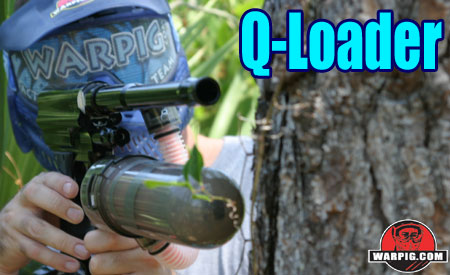  |
|
|
|
|
|
|
  |
|
|
|
|
|
|

What
do you think?
|

Q-Loader By Bill Mills - June 2004 In the summer of 2003, Ancient Innovations, a small company that is both young as a business, and young in respect to the ages of its owners, began publicly demonstrating prototypes of their Q-Loader loading system. One of these demonstrations at the Seattle Pan Am tournament lead to a preview of the system on WARPIG.com.
The prototype system shown in 2003 demonstrated the operation of the system, but was not complete. Parts were still being refined and developed, and some of the components in the prototype were manufactured by stereolithography, a process for computer generating three-dimensional parts. The stereolith prototype parts would not have the same flexibility and friction ratios of production injection molded plastic parts. The prototype system worked, and demonstrated the concept. The author had the opportinuty to test fire it on an Angel IR3 with the COPS system engaged and found that COPS system kept the paintgun from shooting every shot when rapid firing, indicating that the prototype was being outshot by the paintgun. Over the remainder of the year, Ancient Innovations refined and adjusted the design of the Q-Loader system. Their initial mid-fall release date wasn’t met, but in 2003 units were shipping to beta-testers and early in 2004, final production models of the Q-Loader were available to customers.
Most paintball loading systems utilize a bulk holding area, or hopper where paintballs are stored in quantity. To be loaded into a paintgun, they must be sorted into a single file line. In the simplest of hoppers, this happens naturally as balls jostle over the feed-neck and fall into it. In more advanced hoppers electric motors stir the loose paintballs to keep them moving so that they will fall into that feedneck. Further designs use rotating impellers to sort paintballs out of the loose mass and into the feed-neck. With these systems, paintballs are carried in pods, which are used to refill the bulk supply in a hopper.
As the Q-Loader does not operate the same as any other paintgun loader, the manual is the first place to start. This 65-page booklet is heavily illustrated with two photographs on most pages, and very clear explanations of how to install, maintain, clean and repair the Q-Loader. The booklet is also available for review online in PDF format at the Q-Loader web site. A Tournament Package was tested for this review, which began with time spent reading the manual. Because the manual is so thorough, and a warning sheet to follow the manual is included in the Q-Loader box, some may find the Q-Loader a little intimidating to work with. Following the steps in the manual, however installation was trouble free.
Airgun Designs and Worr Game Products have both produced left side feed paintguns with this concept in mind, and the Matrix used for testing was equipped with a left side feed breech. Feeding to the left side instead of the right meant installing the Q-Loader socket inverted on the vertical regulator, which pointed the feed hose downward, forcing it to curve up to the Q-Loader elbow and into the breech. The hose run was then a bit longer than if the feed started in an upward direction, and needed an extra change of direction. This was a situation of concern for the ability of the loader to feed properly. It was decided that if it did not feed well in this configuration a top feed test would be done.
The next step was to cut a section of the corrugated Q-Loader hose about a ¾” longer than what was needed to connect the socket to the hose. Then paintballs were stacked into the tube and the end of the tube trimmed so that the hose would hold a full number of paintballs, rather leaving a portion of a ball sticking out of the end. Included in the kit were o-rings to fit into the grooves of the hose. By placing one on each end of the hose, it attached very securely to the elbow and socket. Even with the recommended use of dish soap to lubricate the o-rings, only one was able to be wedged into the elbow as opposed to the recommended two. This however proved more than adequate to securely hold the hose in place. While the hose and socket were secure, the elbow was not. A small piece of duct tape was used on the 7/8" feedneck to wedge the elbow in place. The elbow fit with no problems inside an FBM clamping feedneck.
|
| Copyright © 1992-2019
Corinthian Media Services. WARPIG's webmasters can be reached through our feedback form. All articles and images are copyrighted and may not be redistributed without the written permission of their original creators and Corinthian Media Services. The WARPIG paintball page is a collection of information and pointers to sources from around the internet and other locations. As such, Corinthian Media Services makes no claims to the trustworthiness or reliability of said information. The information contained in, and referenced by WARPIG, should not be used as a substitute for safety information from trained professionals in the paintball industry. |